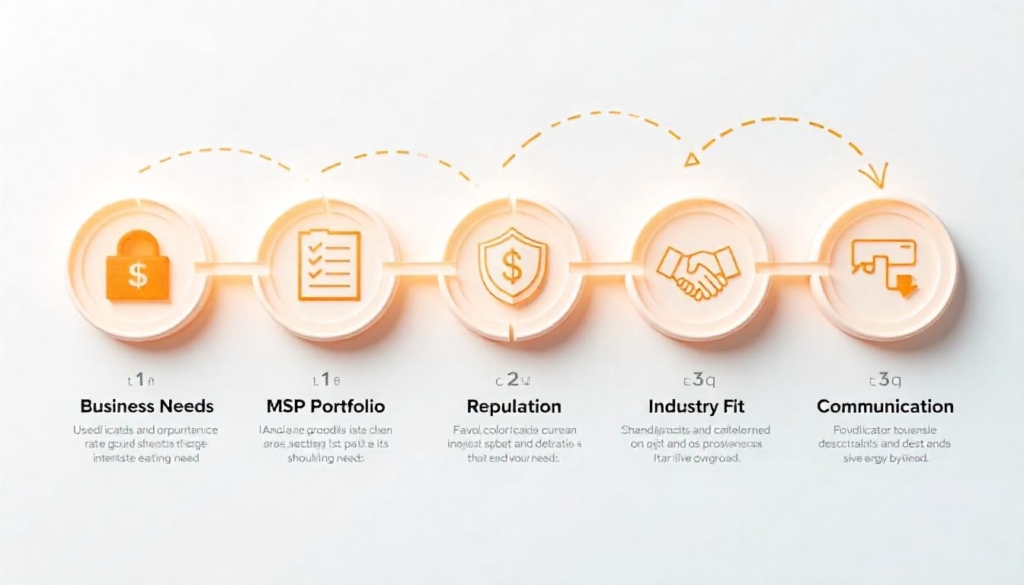Why MSP Selection Is a High-Stakes Decision
Choosing the right MSP company isn’t just a technical decision it’s a strategic one. I’ve helped dozens of businesses, from SaaS startups to multi-location retail chains, evaluate and onboard MSPs. In every case, the choice impacted more than just IT. It affected growth velocity, customer satisfaction, and even long-term profitability.
Yet, many businesses rush the process or focus on the wrong criteria. This guide breaks down how to evaluate MSPs with clarity, experience, and confidence.

Step 1: Understand Your Business Needs First
Before you even Google “best MSP” or check MSP company reviews, take a step back. What are you trying to solve?
Is it uptime? Security? Compliance? Or scaling infrastructure? Maybe you need end-user support across multiple time zones. These requirements should shape your evaluation. For example, if HIPAA compliance is your priority, an MSP with deep healthcare experience matters more than their pricing model.Let’s
In one Chicago-based health-tech firm I consulted for, their leadership assumed all MSPs offered compliance services. They didn’t. That oversight nearly derailed their launch until we corrected the selection criteria.
Related Posts
- MSP Providers in Chicago (2025)
- Leading MSP Providers and What Makes Them Stand Out (2025)
- Case Studies of MSP Websites That Convert (2025)
Step 2: Assess the MSP’s Core Service Portfolio
Not all MSPs are created equal. Some specialize in cloud migrations. Others focus on managed security. And some are glorified break-fix shops dressed in modern branding.
Look for:
- Breadth of services: Cloud, on-prem, hybrid support?
- Cybersecurity capabilities: Do they offer MDR, SIEM, and zero-trust models?
- End-user support: Do they support remote teams effectively?
- Vendor relationships: Are they Microsoft Gold Partners, AWS Certified, etc.?
An MSP should act like a service provider, not just a problem fixer. If their MSP portfolio looks generic, their results will be too.
Step 3: Evaluate Service-Level Agreements (SLAs)
An SLA is more than legal jargon it’s an accountability document. It defines uptime guarantees, ticket response times, backup frequency, and escalation paths.
In my experience, solid SLAs are the single biggest differentiator between MSP examples that deliver and those that excuse failure. Look for SLAs that:
- Use clear, measurable metrics
- Include remedies for missed targets
- Are customized based on your operations
One client once received a 99.9% uptime SLA… with a 72-hour response window for critical issues. That’s not an SLA it’s a liability.
Step 4: Compare Pricing Models and Transparency
Some MSPs use flat-rate pricing, others are tiered, and a few charge by the device or user. There’s no one-size-fits-all here but there should be transparency.
Good MSPs explain their pricing clearly, without surprise fees. They’ll tell you what’s included, what’s extra, and how they scale pricing as you grow. Be cautious of:
- “All-inclusive” plans with vague deliverables
- Lock-in contracts without performance clauses
- Low pricing that hides subpar support
In one case, a startup saved 20% going with a lower-priced MSP in Chicago—but lost three days of uptime during onboarding because of hidden scope exclusions.

Step 5: Investigate Their Reputation and References
Forget slick websites. What do clients say?
A true MSP company that delivers will have:
- Long-term client relationships
- Real testimonials
- Industry-specific case studies
- Willingness to connect you with references
Search beyond their homepage. Check platforms like Clutch, G2, and MSP 501 listings. Reach out to mutual LinkedIn connections. And don’t be afraid to ask MSPs, “Can we speak to one of your existing clients in our industry?”
Pro tip: Ask for references to what the MSP did wrong and how they handled it.
Step 6: Check for Industry Specialization
Industry-specific MSPs understand your compliance, workflow, and user types. Whether you’re in legal, healthcare, finance, or SaaS, a vertical-focused MSP will get you better results.
For example, in a legal firm I advised, onboarding was seamless because the MSP already knew the ins and outs of document management systems and bar association tech compliance. That kind of experience saves time, training, and mistakes.
Step 7: Gauge Cultural Fit and Communication
You’re not just hiring an IT provider—you’re entering a relationship.
Ask yourself:
- Do they communicate in plain language or just technical jargon?
- Are they proactive or reactive in strategy?
- Do they align with your business tempo and growth mindset?
During a mid-market manufacturing project, one MSP won not because they had the lowest bid but because they asked the best questions during the discovery phase. That curiosity led to smarter solutions and a lasting partnership.
Step 8: Understand Their Scalability and Future Readiness
The best MSP for today should still be the best MSP as you grow. Ask:
- Can they support multi-site, multi-cloud environments?
- How do they handle scaling users during high-growth phases?
- What automation or AI solutions are they planning to implement?
An MSP who’s stagnating will drag you down. One who’s innovating becomes a strategic advantage.
Related Posts
- Steps to Selecting the Best MSP for Your Needs (2025)
- MSP Providers in Chicago (2025)
- Key Technologies Shaping the Future of MSP Services (2025)
Key Takeaways
Selecting the right MSP company requires clarity, not speed. It’s a business-critical decision with long-term implications on performance, security, and growth. By evaluating service quality, reputation, alignment, and future scalability, you’ll avoid costly misfires and land the right partner not just a vendor.
- Define your internal needs before shortlisting MSPs.
- Prioritize service depth, SLAs, and industry experience.
- Vet real client feedback not just websites or case studies.
- Consider cultural fit, communication style, and growth alignment.
- The wrong MSP slows you down. The right one becomes your competitive edge.
FAQs
What’s the biggest red flag when evaluating MSPs?
Vague SLAs, unclear pricing, and no industry references are serious warning signs.
How do I compare MSP pricing models?
Ask what’s included, how overages work, and what’s excluded. Don’t assume “flat fee” means full service.
Should I choose a local MSP or a national one?
It depends on your support needs. A local MSP in Chicago, for example, may be ideal for in-person support, while national firms excel at remote scaling.
Is industry experience essential?
Absolutely. An MSP familiar with your compliance and workflows can onboard faster and avoid expensive mistakes.
